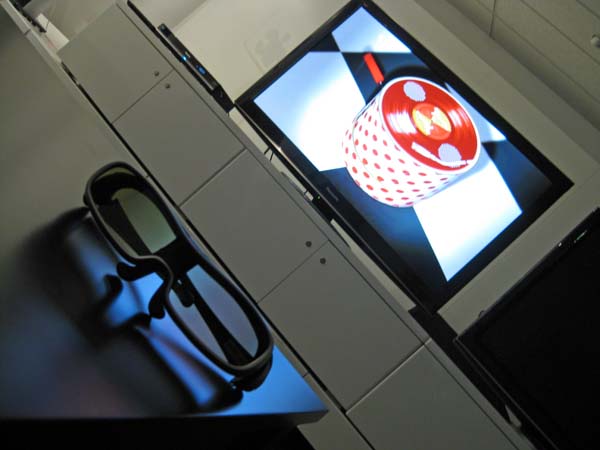
In the middle of this year, the TV market is going to be attacked by bigger, better and badder flat panels. This new breed of screen does everything its predecessors do, but adds one new little feature: 3D Panasonic this morning was the first manufacturer to show off one of their 3D TVs, and I was fortunate enough to get a taste of what’s to come…
The most important thing to note is that this is not the same 3D you saw when you went to watch Avatar at the movies. The glasses that will come with the new 3D plasmas aren’t your passive polarised type that look like cheap Buddy Holly specs (or even those “designer/” glasses you can get now). The glasses with the new 3D Viera displays are battery-powered active shutter glasses, which sent a different signal to each eye 100 times a second in sync with the 3D display from the TV. They also look like they come from the future, which not only makes you feel cool in your geekiness, but also means you can wear them over prescription glasses comfortably, while an adjustable nose piece helps them fit kids faces.
The display itself looks identical to any other Viera model you see on store shelves. Somewhere in the front is an IR transmitter that beams out the signal to sync with the glasses, but it certainly doesn’t stand out. And that’s worth mentioning – not only does the 3D panel look just like a normal 2D screen, but it also displays normal 2D, Full HD content as well. Two dimensional content Panny showed us on the set looked pretty sweet, that’s for sure.
And as for 3D performance – it was impressive. Just like when watching 3D at the cinema, I developed what I’m beginning to call a 3D headache, but that doesn’t mean it was bad. The 3D content they showed us leant heavily on the gimmicky side though – balls flying at the screen, asteroids flying at the screen, water splashing up at the screen, sand being kicked up at the screen… You know, pretty much anything to make you feel like something was coming straight for you. The illusion is sort of broken when the object disappears meters in front of you, but it still looks good.
The glasses have a pretty good viewing angle, and they still worked about 4-5 metres from the screen. As a battery saving feature, they automatically switch off if they aren’t receiving the IR signal for a period of time, but they do switch on again when you turn back to the screen. And unlike polarised glasses, they also work if you turn your head sideways (if you’re lying down, for example).
At the moment, there’s still no price or exact date set for launch. There’s also no firm decision as to how many pairs of glasses will be included in the box. But what is known is that buying the TV is just a part of your system upgrade if you want to get 3D in the home – you’ll also need to buy a 3D capable Blu-ray player and an HDMI 1.4 cable. And that doesn’t even begin to answer the question of content…
Personally, I’ll never be buying a 3D TV thanks to the fact I get those wonderful 3D headaches, but if you love the idea of watching sports and blockbuster movies in 3D at home, and aren’t too worried about binocular dysphoria, you’ll almost definitely be impressed by the Panny panel.